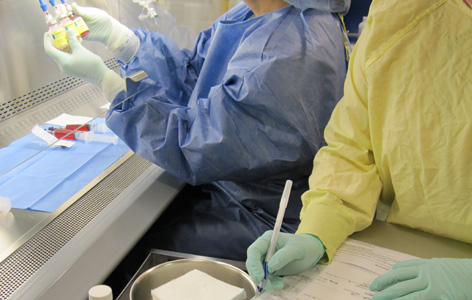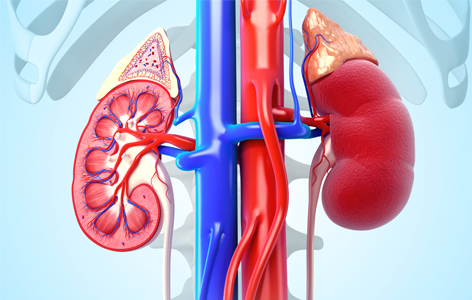 As UHN's monthly research newsletter, NRx reports on the full spectrum of research from UHN's five research institutes: the Princess Margaret (PM) Cancer Centre, the Toronto General Research Institute (TGRI), the Toronto Western Research Institute (TWRI), the Toronto Rehabilitation Institute (TRI) and the Techna Institute (Techna).
As UHN's monthly research newsletter, NRx reports on the full spectrum of research from UHN's five research institutes: the Princess Margaret (PM) Cancer Centre, the Toronto General Research Institute (TGRI), the Toronto Western Research Institute (TWRI), the Toronto Rehabilitation Institute (TRI) and the Techna Institute (Techna).
In this issue you can read about:
- The need for new safety measures for oral chemotherapeutics
- Differences between hospitalization rates in real life vs clinical trials
- Non-toxic imaging of cells and tissues in three-dimensions
- Why more men get ankylosing spondylitis than women
- Using speech to diagnose the earliest stages of dementia
- A new biomarker that could diagnose kidney disease severity
We hope that you will find NRx informative. If you have feedback or questions, please contact www@uhnresearch.ca.
Christopher J. Paige, PhD, FCAHS
Executive Vice President, Science and Research
University Health Network
Chemotherapy dispensing has many more systematic checks for drugs delivered intravenously than orally

Health care professionals perform systematic checks of potentially hazardous medications (above) to ensure that patients receive the right dose.
When a pharmaceutical mixing error that was first noticed in March 2013 caused over a thousand Ontario cancer patients to receive the wrong dose of intravenous (IV) chemotherapy, an inquiry was launched. Results of the inquiry led to the establishment of new preventative measures; however, the scope of the inquiry and practice improvements were limited to preventing the errors associated with administering IV drugs. Thus, safety issues for drugs that are administered through other means were not addressed.
In a recent study on chemotherapy drug dispensing in Nova Scotia, Techna Affiliated Faculty Dr. Patricia Trbovich and Clinical Engineer Melissa Griffin found that administration of IV chemotherapy involves a total of 57 systematic checks to help prevent errors. Checks can include verifying information, such as a pharmacist verifying a patient's blood test results to ensure that they are eligible to receive treatment or looking up possible interactions with other medications. To be systematic, a 'check' must be clearly defined as part of a health care provider's role and be performed consistently.
Conversely, oral chemotherapy—which poses many of the same toxicity risks—has only six systematic and independent checks. For oral chemotherapy, which is typically dispensed in the community and administered in the home, a community pharmacist was the only qualified professional involved in independent systematic checks.
“There is an enormous opportunity for community pharmacists and other health care professionals to take on an expanded role in improving patient safety,” concludes Dr. Trbovich, who is working with Cancer Care Ontario to develop new guidelines for chemotherapy dispensing.
This work was supported by Cancer Care Nova Scotia and The Princess Margaret Cancer Foundation.
Comparison of independent error checks for oral versus intravenous chemotherapy. Griffin MC, Gilbert RE, Broadfield LH, Easty AE, Trbovich PL. Journal of Oncology Practice. 2015 Sep 29. [Pubmed abstract]
Hospitalization rates due to chemotherapy differ between real world and clinical trial settings

A common chemotherapy side effect is loss of red blood cells, which can lead to severe fatigue, dizziness and irregular heartbeat.
Before chemotherapy drugs can be used in real world settings, they must undergo testing in clinical trials. These trials provide physicians with important knowledge about potential side effects that range from mild to severe, including those that require hospitalization.
Because physicians use hospitalization rates in clinical trials to help decide which chemotherapy drug to prescribe, it is important to know whether the rates seen during clinical trials reflect those in the real world; however, no explicit comparisons have ever been performed.
A new study by Drs. Rebecca Prince (Clinical Research Fellow, PM Cancer Centre) and Monika Krzyzanowska (Medical Oncologist, PM Cancer Centre) aimed to identify the frequency of chemotherapy-related hospitalization and the factors that led to it. By performing a comprehensive review of the medical literature, they found this data was rarely reported in clinical trials. Of the studies that did report hospitalization rates, the researchers found that people receiving chemotherapy for lung cancer were almost eight times more likely to be hospitalized than those receiving similar treatments in clinical trials. The factors leading to this increase, however, could not be determined.
“More rigorous reporting of hospitalization due to chemotherapy-related side effects in clinical trials would enable the creation of standardized risk measurements for chemotherapy drugs,” explains Dr. Krzyzanowska. “As frequent hospitalization reduces the quality of life for patients and incurs costs to the health care system, knowledge of these risks would help patients and doctors make decisions about the most appropriate treatment options and identify opportunities to improve care.”
This work was supported by The Princess Margaret Cancer Foundation.
Hospitalizations during systemic therapy for metastatic lung cancer: a systematic review of real world vs clinical trial outcomes. Prince RM, Atenafu EG, Krzyzanowska MK. JAMA Oncology. 2015 Sep 17. [Pubmed abstract]
An innovative, non-toxic imaging agent enables three-dimensional imaging of live cells and tissues

Porphyrin nanoparticles could be used to reveal detailed structural information about multilayered tissues, such as the skin and to inform the treatment of disease.
Microscopy has become an increasingly sophisticated and essential tool for scientists who want to visualize cellular structures with precision. One microscopy technique that exemplifies this increased level of sophistication is nonlinear optical microscopy (NOLM), which enables the creation of high contrast three-dimensional images of cells and tissues.
NOLM has proven particularly useful for imaging the interface between two different materials—for example, where the cell membrane comes in contact with the liquid contents of the cell; however, a disadvantage of this technique is that it requires the use of toxic imaging agents.
PM Senior Scientist and Techna Core Lead Dr. Gang Zheng has developed a new non-toxic imaging agent that significantly enhances the quality of images generated using NOLM. The imaging agent is a nanoparticle that contains naturally derived compounds known as porphyrins, which form clusters within the nanoparticle. Use of this agent significantly enhances the intensity and contrast of NOLM live cell images. When the agent enters the cell, the porphyrin clusters degrade and become readily observable using a different type of fluorescence imaging.
Dr. Zheng explains, “These clusters are robustly produced, safe and easily incorporated into small vesicles, which makes them ideal for numerous biomedical applications such as drug delivery. The fact that they can be easily tracked inside the cell is particularly advantageous as it gives us an opportunity to examine how the nanoparticles degrade and how their presence influences cell function.”
This work was supported by the Natural Sciences and Engineering Research Council of Canada, the Canadian Institutes of Health Research, the Terry Fox Research Institute, the National Science Foundation of China, the Canada Foundation for Innovation, the Joey and Toby Tanenbaum/Brazilian Ball Chair in Prostate Cancer Research and The Princess Margaret Cancer Foundation.
Organized aggregation of porphyrins in lipid bilayer for third harmonic generation microscopy. Cui L, Tokarz D, Cisek R, Ng KK, Wang F, Chen J, Barzda V, Zheng G. Angewandte Chemie International Edition. 2015 Sep 29. [Pubmed abstract]
Study reveals why more men get ankylosing spondylitis and why symptoms differ between sexes

Individual discs in the spine can fuse together in severe cases of ankylosing spondylitis, leaving the spinal column rigid and inflexible.
Ankylosing spondylitis (AS) is a form of chronic arthritis that causes pain and stiffness in the spine and other joints. Both men and women are affected by AS, although important sex differences exist: men are three times more likely to develop the disease, while women have slower disease progression and experience increased spinal pain. The reason for these apparent sex differences has remained a mystery until now.
A team of investigators led by TWRI Senior Scientist Dr. Robert Inman collected blood samples from male and female AS patients and then screened their blood for factors associated with the body’s immune response. A key feature of AS is activation of the immune system and consequent inflammation. Eric Gracey, an Immunology graduate student in Dr. Inman’s lab, found that levels of IL-17A proteins and Th17 cells, two factors that promote inflammation, were elevated in male AS patients.
Dr. Inman’s finding may lead to a paradigm shift in the development of treatment options for AS. “We have identified a clear difference in how the immune system is activated in male and female AS patients. It is vital that we use this new knowledge to specifically design more precise treatment options for each sex,” explains Dr. Inman.
This work was supported by the Canadian Institutes of Health Research, the Arthritis Research Centre and the Toronto General & Western Hospital Foundation.
Sexual dimorphism in the Th17 signature of ankylosing spondylitis. Gracey E, Yao Y, Green B, Qaiyum Z, Baglaenko Y, Lin A, Anton A, Ayearst R, Yip P, Inman RD. Arthritis & Rheumatology. 2015 Oct 16. [Pubmed abstract]
Researchers analyze speech using machine learning to identify the earliest stages of dementia

Alzheimer disease destroys the brain’s structural and functional networks, which reduces brain cell activity and leads to symptoms such as dementia.
Physicians usually diagnose Alzheimer disease (AD) by looking for signs of memory loss or unexplained changes in personality or behaviour. Unfortunately, by the time these changes occur, brain tissue has already been irreversibly damaged. Thus, rather than curing the disease, existing treatments only serve to lessen the symptoms.
A study by TRI Scientist Dr. Frank Rudzicz has explored a new approach for diagnosing AD at earlier stages. By relying on the fact that patients with AD exhibit language deficiencies that increase in severity as the disease progresses, Dr. Rudzicz explored whether analyzing speech could provide a way to identify those at risk.
The research team trained a computer to distinguish between individuals with AD and healthy controls by using audio files that were taken during hospital visits. They programmed the software to consider the subtle linguistic differences that are often observed in individuals with AD. This newly-designed classification system could accurately identify individuals with AD with over 81% accuracy.
"Although memory impairment may be the most definitive symptom in the diagnosis of AD, it is not necessarily the most sensitive measure of overall or specific brain function,” explains Dr. Rudzicz. “Our system offers a highly sensitive instrument for detecting AD, which could be used to detect the early stages of disease when symptoms are not as obvious. It also gives us a valuable tool with which we can examine the different ways that AD presents itself.”
This work was supported by the Natural Sciences and Engineering Research Council of Canada, the Alzheimer's Association, the Alzheimer Society of Canada, the National Institutes of Health and the Toronto Rehab Foundation.
Linguistic features identify Alzheimer's disease in narrative speech. Fraser KC, Meltzer JA, Rudzicz F. Journal of Alzheimer's Disease. 2015 Oct 15. [Pubmed abstract]
New findings could lead to a genetic test that provides patients with a more accurate prognosis

The kidneys are two bean-shaped organs in the lower back that remove excess water and waste from the body in the form of urine.
Autosomal dominant polycystic kidney disease (ADPKD) is an inherited condition characterized by enlarged kidneys with numerous fluid-filled cysts, which distort the architecture of the kidneys and impair their function. The severity of the disease progresses over time and by the age of 55 half of people with ADPKD require dialysis or a kidney transplant.
Although researchers know that ADPKD is caused by changes in two genes known as PKD1 and PKD2, they do not fully understand how the different types of genetic changes impact the severity of the disease. To address this, a team led by TGRI Senior Scientist Dr. York Pei examined the relationship between genetic changes in PKD1 and PKD2 and health outcomes in 709 patients from 220 families with ADPKD.
Researchers discovered that all participants with ADPKD carried one of four classes of genetic changes. The most common class, observed in 38.3% of those with ADPKD, was located in the PKD1 gene and put participants at high risk of severe disease and death. In contrast, participants carrying one of the other three classes of changes were found to be at a reduced risk of severe disease and death.
Taken together these findings lay the foundation for the development of a new gene-based test called 'next generation target sequencing' that is able to accurately predict the severity of patients' disease and advance personalized medicine.
This work was supported by the Canadian Institutes of Health Research, the National Institutes of Health and the Toronto General & Western Hospital Foundation.
Refining genotype-phenotype correlation in autosomal dominant polycystic kidney disease. Hwang YH, Conklin J, Chan W, Roslin NM, Liu J, He N, Wang K, Sundsbak JL, Heyer CM, Haider M, Paterson AD, Harris PC, Pei Y. Journal of the American Society of Nephrology. 2015 October 9. [Pubmed abstract]
 UHN has been named Canada’s top-funded research hospital in RE$EARCH Infosource Inc.’s Top 40 Research Hospitals 2015. The annual study ranks research hospitals across Canada according to their research funding data. Funds that were considered included grants, contributions and contracts from all internal and external government and non-government sources. UHN earned its top position for reporting research expenditures over $303 million in the 2014 fiscal year. This is the fifth year in a row that UHN tops the list.
UHN has been named Canada’s top-funded research hospital in RE$EARCH Infosource Inc.’s Top 40 Research Hospitals 2015. The annual study ranks research hospitals across Canada according to their research funding data. Funds that were considered included grants, contributions and contracts from all internal and external government and non-government sources. UHN earned its top position for reporting research expenditures over $303 million in the 2014 fiscal year. This is the fifth year in a row that UHN tops the list. TGRI Senior Scientist and McEwen Centre Researcher Dr.
TGRI Senior Scientist and McEwen Centre Researcher Dr.  On November 6, the American Association for Cancer Research (AACR) launched an international initiative called Genomics, Evidence, Neoplasia, Information, Exchange (GENIE) that will enable the sharing of sequencing data between seven world leading genomics institutions.
On November 6, the American Association for Cancer Research (AACR) launched an international initiative called Genomics, Evidence, Neoplasia, Information, Exchange (GENIE) that will enable the sharing of sequencing data between seven world leading genomics institutions.